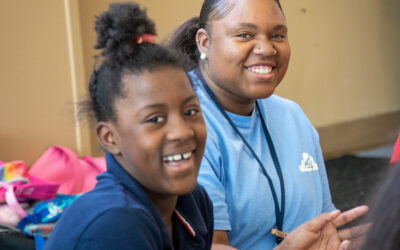Demonstrating social awareness is the ability to comprehend diverse viewpoints, demonstrate empathy, value diversity, and grasp social norms, all of which are fundamental for fostering thriving relationships. This entails:
- Adopting varying perspectives.
- Valuing and celebrating diversity.
- Displaying empathetic responses and respect towards others.
- Understanding and adhering to social and ethical behavioral standards.
Try the techniques below to nurture these essential skills in children, helping them navigate social interactions with confidence and compassion.
Practicing Social Awareness Skills at Home
We use Words to Live By to help kids learn the fundamental skills of social emotional learning. Words to Live By breaks down the competency into two lessons:
-
I understand others are unique. I want to learn more about everyone I meet: learn more about others and get along with different types of people
-
I want to step into their shoes and see what they are going through: respond to another person’s feelings and show empathy
Learn More About Others and Get Along with Different Types of People
Tip #1: Try new things together
Expose the family to new experiences to expand everyone’s horizons and learn more about other people, cultures, and places.
For example, if you always go to the same restaurant, try a new restaurant that serves food from a different culture, such as Indian, Chinese, Japanese, Middle Eastern or Italian. Experimenting with new foods and flavors help kids expand their knowledge of different ingredients and cooking styles.
Tip #2: Learn a new skill
Encourage everyone in the family to start practicing a new skill and celebrate everyone’s success while learning that skill.
For example, a family might choose to learn how to bake homemade bread together, researching recipes and gathering ingredients. They might watch tutorials, assign tasks, and recognize small achievements during the baking process. After finishing a loaf, they might share it with friends to celebrate.
Respond to Another Person’s Feelings and Show Empathy
Tip #3: Encourage family members to use their voice
Encourage everyone in the family to share their thoughts, feelings, and opinions about situations and decisions that affect them.
For example, a family might use a voting system to decide on family activities by creating a weekly or monthly activity list that includes options suggested by each family member— a “Family Fun Day” where everyone contributes an activity idea. Each family member then votes on their top three choices anonymously. The activity with the most votes becomes the next family activity. This process encourages sharing opinions and feelings as everyone has a chance to suggest and vote for activities they enjoy.
Tip #4: Take time to discuss the feelings of others
Create opportunities to discuss how others feel in given situations (through television, movies, news stories, personal experiences, etc.)
For instance, watch a movie or TV show together that presents characters facing different emotional challenges. Afterward, discuss how each family member thinks the characters felt and why, relating these emotions to real-life situations. Similarly, read age-appropriate news stories about people’s experiences and discuss the emotions involved, encouraging empathy and understanding. Or, try sharing personal experiences within the family to allow everyone to express their feelings and perspectives, fostering open communication and perspective-taking.













